

|
Chapter 9 Captain King When he returned to duty on
June 4th, James’ unit had been ordered to stop at the King Ranch.
“Richard King, whose ranch near
Corpus Christi became a center of military activity, informed Ford that
he would supply the Rio Grande expedition with all of the beef it
needed.” (Ref. 1008) Richard King
and his young wife, Henrietta, had moved from Brownsville to the ranch
of Santa Gertrudes in 1856 – the same year James and Jane had arrived
in Texas from Virginia.
Captain Richard King married Henrietta Maria Chamberlain, the daughter of Hiram Chamberlain, on December 19, 1854. The couple had five children: (1) Henrietta (called Nettie) Morse King (Atwood), (2) Ella Morse King (Welton), (3) Richard King, (4) Alice Gertrudis King (Klegerg), and (5) Robert E. Lee King. Capt. King had an uncanny knowledge about business opportunities, and he ended up creating a ranch that was so large it was considerably bigger than the state of Rhode Island. As one visitor commented, “King’s Rancho is distant from Brownsville only 125 miles, and we have been six days in reaching it.” (Ref. 3302) The Civil War did three things for Richard King:
it gave him the opportunity to make a vast fortune, it added to his
already formidable character, and it led to the opening of the markets
for beef that confirmed his faith in ranching. (Ref.
William Broyles) 111
inland, and put an end to this vital Confederate supply
line. “The very life line of
the Confederacy, the cotton road, lay across Neuces County. The
ever increasing flow of fleecy cotton crossed the Neuces River at Santa
Margarita, crossing near San Patricio and rolled southward through
Banquete toward Matamoras and the mills of England.” (Ref.
3240) 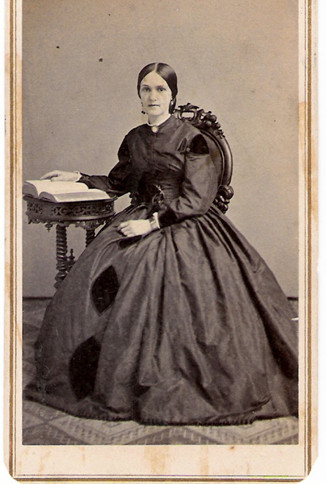 Elizabeth (Bessie) Ware Britton Photo owned by James and Judy Ware James Ware became associated with the King family
through his service in the military, and possibly even through his
legal business before the war. The family ties grew tighter when
his sister, Elizabeth Alexander Ware (Bessie), “joined her brother, James, in Texas about
1858, and there married Dr. Britton.” (Ref. 3344)
The couple wed in Galveston on March 10, 1864, and Bessie shortly had a
baby boy they named after her and her brother’s Virginia father - Josiah Ware Britton. 112
Cornelia Ware Anker, later wrote that Elizabeth “showed me, probably sixty five years
later, a little purse which he had handed her when he told her goodbye,
in it was two hundred dollars in gold. He told her not to use it
except in case of emergency. She never used it. I remember
figuring what she had lost in interest, by keeping it for sentimental
reasons.” (Ref 3344) Cornelia Anker also wrote about the incident in her
family history. “She
[Elizabeth] arrived home [Springfield] and shortly thereafter her baby
died and on the same day she received the news of the death of her
husband of yellow fever. Her great grief made a deep impression
on Father, as a little boy.” (Ref. 3344) 113 When James was growing up, he was especially close to
both of his two younger sisters, Elizabeth (Bessie) and Lucy Balmain
Ware, who married E.P.C. Lewis – a descendant of the Washington
family. In 1866, Bessie was back at home in Virginia when
Lucy (who had previously already lost five children) gave birth to her
last child, named appropriately for her mother. Sadly, she died
at the birth of this baby. It was only natural that her sister,
who had just buried her own child less than a year earlier, would offer
to raise baby Lucie until Edward Lewis remarried about five years later.
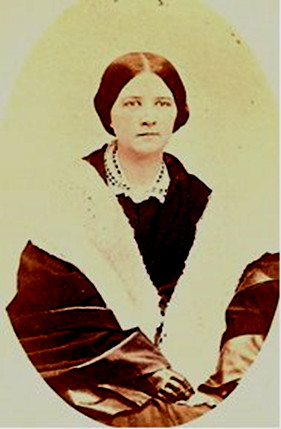 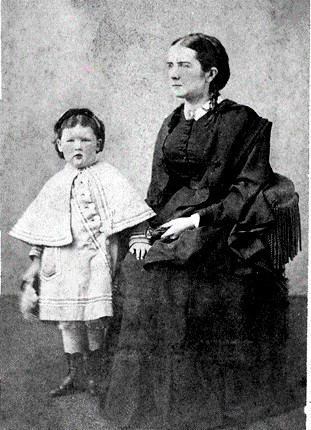 Lucy Balmain Ware Lewis | Lucy Lewis with Aunt Bessie Britton Photographs owned by James and Judy Ware
114
Since Dr. Britton died in Corpus Christi and Bessie was
home in Virginia at the time, his funeral was handled by his twin
sister, Lizzie Davis. His marker not only mentions that he was a
twin, but draws attention to the fact that he was only 27 years old at
the time of his death. 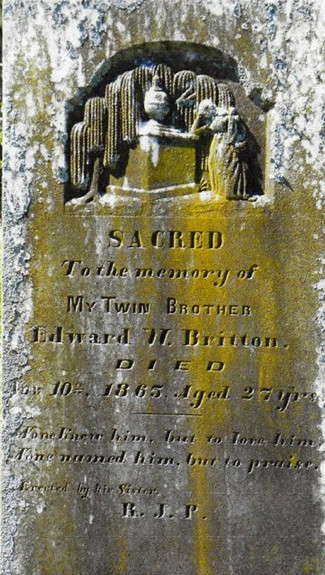 Grave marker for Dr. Edward W. Britton According to Cornelia: 115 are
under my rule, you can send me away, but that is the way it is.’”
He admired her very much for her stand and she and the Kings were
friends for life. In speaking of Dr. Britton, Annie
Moore Schwien, a local resident of Corpus Christi, wrote that Dr.
Wharton’s “widow
was later a governess in the home of Mrs. Henrietta King.”
(Ref. 2602) Author William Broyles also
noted that “life
on the ranch became steadily more civilized. There was a cook and a
Virginia governess.” (Ref. 753) When James
came to the King Ranch in early June of 1863, however, his sister had
not even married yet. His orders
read:   The following are requisition orders James placed
during June. 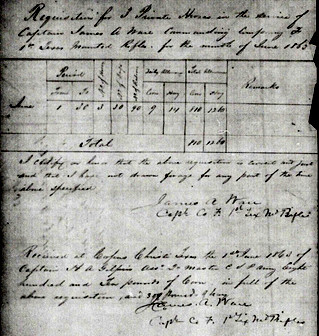 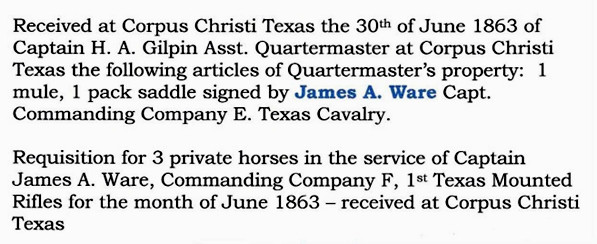 Ref. 2086 116 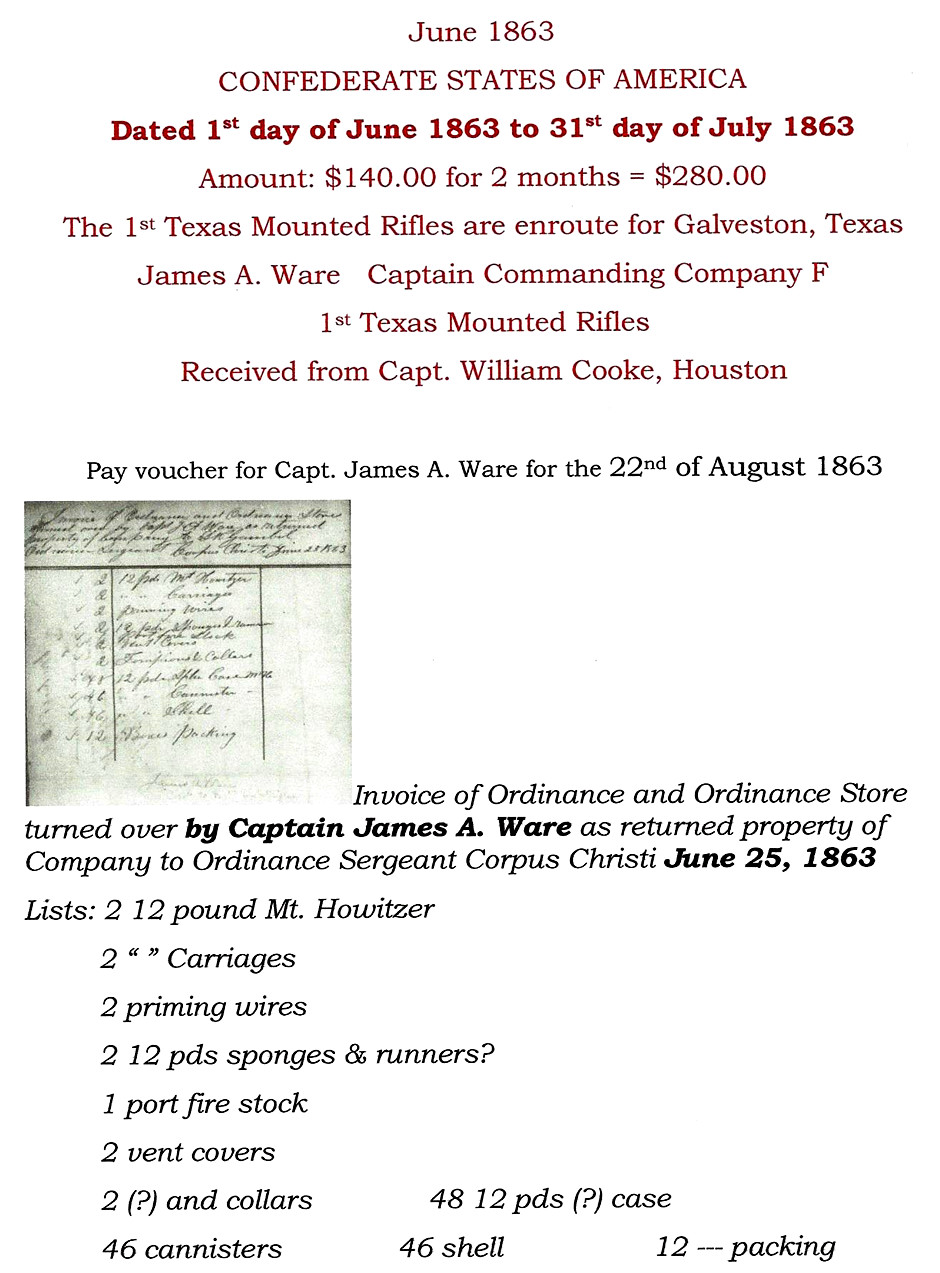 117 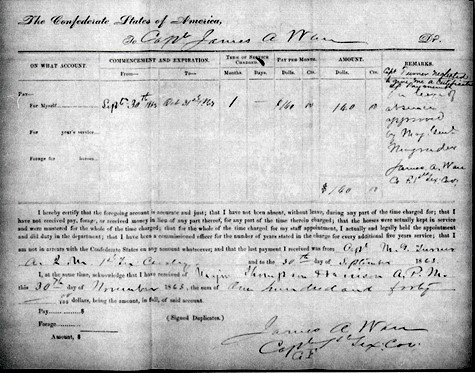 This invoice is dated September 30th to October 31, 1863 As invasion “tension
mounted in 1863, the 1st Texas cavalry remained on constant patrol.”
(Ref. 1008) The Federal Army continued to want to “put a union presence in Texas - - [and] a
campaign began in September 1863 with the Union’s ill-fated assault
against Sabine Pass.” (Ref.1008)
Sabine Pass is a narrow, six-mile long gorge that channels the Sabine
River, the boundary between Texas and Louisiana, into the Gulf of
Mexico. “The union army officer
assigned the task of invading and conquering Texas in 1863 was Major
General Nathaniel P. Banks.” (Ref. 1008)
On September 8, 1863, the Union Navy, with 5,000 men, attempted to
enter one of the channels. There were four Union gunboats in play
– the Sachem, the Clifton, the Granite City, and the Arizona.
General Magruder had become aware of the enemy's intention to attack
the Pass a few days earlier and had ordered several regiments to
Beaumont and to the Pass. “Magruder
went personally to Sabine Pass to supervise the continued preparations
for defending his district.” (Ref. 757)
Under Lt. Dick Dowling’s direction, the Confederate troops had hidden
in bunkers all morning to escape Union shelling. When they
emerged to begin their own bombardment of the Union gunboats (as they
came within firing range), the Confederates fired with tremendous
accuracy. Two of the Union gunboats, the Clifton and the Sachem,
were disabled or forced to surrender within minutes. The
Confederates continued with devastating fire and after only 45 minutes,
the Union boat retreated. “The
Confederate victory was 118
total. As one
captured Union officer said to Lt. Dowling after the battle, ‘You and
your 46 men in your miserable little fort in the rushes have captured
two gunboats, a goodly number of prisoners, many stands of small arms,
and plenty of good ammunition, and that is not the worst of your boyish
tricks: you have sent three Yankee gunboats, 5,000 troops, and a
major-general out to sea in the dark.’ The Battle of Sabine Pass
has often been described as the most one-sided Confederate victory of
the entire war.” Bibliography:
Handbook of Texas Online, http://www.tsha.utexas.edu/handbook/online/articles/SS/qes2.htm  Pay voucher for James
Ware from Sept. to Oct. 1863
119 Scouting became the main business for James for the
next few weeks. “On October
14, 1863, Colonel Augustus Buchel of the 1st Texas Cavalry was ordered
to take command of Niblett’s Bluff. He was instructed to keep
scouts out as far as the Calcasieu River.” (Ref.
757) As of November 1st, “Bee had another fifteen men of company F
[James’ company] positioned at Point Isabel. Both companies
reported on November 2nd that they had sighted fifteen vessels off the
island of Brazos Santiago.” (Ref. 1008) In
a letter written by General Bee on November 5, 1863, he reported that
he had been forced to evacuate Fort Brown but had destroyed items that
the enemy might use. He wrote, “I
shall await orders at King's ranch. My small command of 100 men
are much exhausted, as we have been constantly on duty for ten days.”
By November 8, 1863, it was clear that Bee had indeed arrived at King’s
Ranch because he sent a lengthy telegram to headquarters in Houston
from there. “He issued orders
that all cotton wagons bound for Brownsville be rerouted to Eagle Pass.”
(Ref. 2008) 120
information received, I will have to approach within a few miles of the San Antonio River to obtain grass, so barren and parched is the country.” (Ref. 3248) We know that sometime in the fall of 1863, “James was wounded and returned home to
recuperate.” (Ref. 775) It would make
sense that his injury must have occurred around November 21st or
23rd since records show him being ‘absent with leave’ for 35 days
with the application being approved by Maj. General Magruder. The
dates would also coincide with the fact that Jane became pregnant in
late November. It must have been wonderful for the couple to be
together again, even if the reunion was caused by an injury and ended
up being all too short. James fully recovered and was able to
report back to duty after the 35 days. 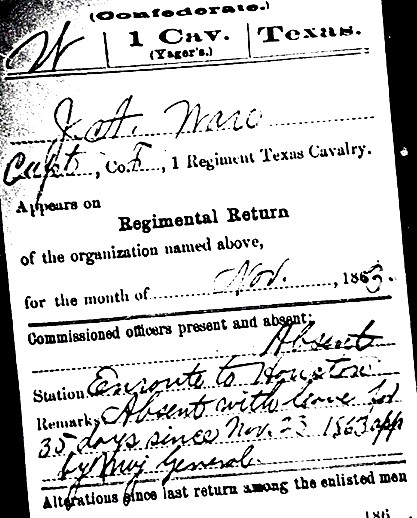 Furlough for James Ware 121 Then, on December 13, 1863, James found himself at the
Santa Gertrudis Ranch of Captain King. He was still on furlough
but had found some interesting news that he wanted to get to
headquarters as soon as possible. He wrote the following long
letter to Captain Turner, the Acting Attorney General: 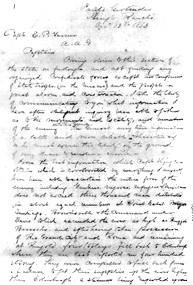 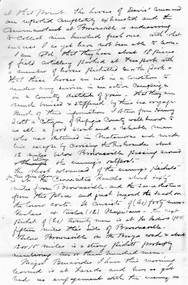 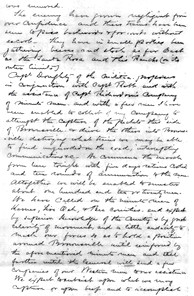 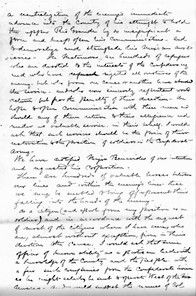 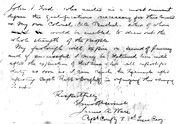 Original letter of December 13, 1863 transcription on the following pages done by Judy C. Ware Bold lettering done by Judy C. Ware for research purposes.
Coming down to this section of the state on furlough and not finding any organized Confederate
forces except two companies of state troops (in the Nueces) and the
people in great alarm and consternation, I take the liberty of
communicating to you what information I have, after diligent inquiry,
been able to gather as to the movements and locality and numbers of the
enemy on the Rio Grande. The General may have information of a
later and more reliable character and if so, he must excuse this
liberty on the grounds of my desire to render a service. 122
barracks and, after
having taken possession of Rio Grande City and Roma and remaining at
Kingsville for (4) days, fell back to Edinburg where they are last
reported 400 strong. They were compelled to fall back from a
failure to get their supplies up the river higher than Edinburg, a
steamer being reported aground at that point. The horses of
Davis’ command are reported completely exhausted and the commandant at
Brownsville is endeavoring to collect 900 fresh ones with what success
I have not been able to learn. I am told they have about 18
pieces of field artillery parked at Freeport with a number of horses
picketed near the park and that these horses are not in a condition to
render any service in an active company in a county destitute of grain
- that they are much bruised and stiffened by the sea engagement.
Much of this information I obtained from Henry Scott, a citizen of
Refugio County - well known to us all - a good scout and a reliable man
who was detained in Matamoras and made his escape by crossing the Rio
Grande about 12 miles below Brownsville passing around and between the
enemies outpost. The most advanced of the enemy’s pickets in this
direction is at the Corricitas Rancho about 60 miles from Brownsville
and the same distance from this place and just beyond the sound on the
lower unit (?). It consists of forty (40) men - Yankees and
twelve (12) Mexicans. The next picket of twenty (20) men is at
Los Indios fifteen (15) miles this side of Brownsville. Below
Brownsville on the Brazos Road and about 12-15 miles is a strong picket
probably numbering two or three hundred men. 123
communications,
etc. We commence the march from here tonight with five day
rations cooked, and ten rounds of ammunition to the man.
Altogether we will be enabled to muster about one hundred and ten or
twenty men. We have called the minutemen of Karnes, Live Oak, and
Bee Counties. By superior knowledge of the county and by great
clarity of movement and a little audacity to march our forces so as to
hold a position around Brownsville until reinforced by the
aforementioned minutemen and still farther until the general will send
a few companies of our Western men to our assistance. We expect
to subsist upon what we may capture or upon beef and to accomplish a
neutralization of the enemy’s immediate advance into the county, of his
attempt to hold the upper Rio Grande by so a significant a force and to
keep open his communications, and neutralize and stampede his Mexican
auxiliaries. In Matamoras are hundreds of refugees who are
devoted to the interests of the Confederacy and who have rejected all
overtures of the enemy - but who, from one cause or another, have
abandoned the service and who now sincerely repent and would return but
for the penalty of their desertion. We have open communication
with these men and should any of them return to their allegiance and
render us valuable service in their behalf, I would ask that such
services should be the price of their restoration of position as
soldiers in the Confederate Army. We have notified Major
Benavides of our intention and have requested his cooperation.
There are hundreds of valuable horses between our lines and within the
enemy’s lines - these we may be enabled to bring off and prevent their
falling into the hands of the enemy. As a citizen (and apart from
my position as a soldier) and in accordance with the request of most of
the citizens where I have seen (who are, almost without exception, firm
in their devotion to the cause), I would ask that some
officer of known ability as a partisan leader with a knowledge of the
county and the people with a few such companies from the Confederate
service as he might select be sent to operate West of the Nueces and
would suggest the names of Colonel John S. Ford who unites in a most
imminent degree the qualifications of this command and my own colonel -
Colonel A. Buchel - either 124
of
whom would be enabled to draw out the whole strength of the people. James A.
Ware Captain, Company F, First Texas Cavalry J. A. W.
From the decisions being made at the King Ranch that
winter, James seemed to have his finger on the pulse beat of where
confederate activity was heading. 125
126
|
|
This site maintained by John Reagan |